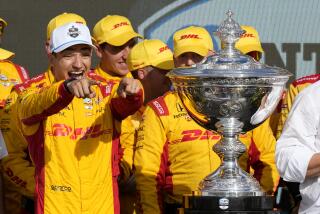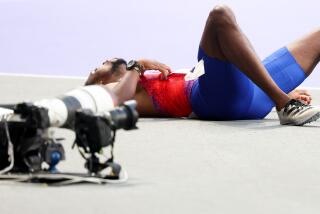IndyCar driver Charlie Kimball keeping pace with diabetes
Other than driving a race car 200 mph while monitoring a life-threatening illness, Charlie Kimball is a normal guy.
Kimball will drive in the Toyota Grand Prix of Long Beach on Sunday. He is 26 and is two races into his rookie season on the Izod IndyCar circuit. He already has a top-10 finish, and is somebody with almost unlimited promise for a lucrative racing future on the highest level.
Except for the diabetes.
“It was Oct. 16, 2007,” Kimball recalls. “I went to a doctor because I had a skin rash. He looked at it, said he’d give me some cream and then asked me the question that changed my life forever.”
The question was the normal “Is there anything else about your recent health that is bothering you?”
Kimball told the doctor he had been thirsty a lot, drinking as much as seven or eight bottles of water a day.
The doctor put him on a scale and it showed that Kimball had lost 25 pounds in seven days. To the doctor, it all added up to diabetes. To Kimball, it was something he had heard about and paid little attention to, same as most of us.
“When he said diabetes,” Kimball says, “my first reaction was, well, cool. Now he knows what it is, he can prescribe some medicine and I’ll be on my way.”
Not exactly.
Kimball has Type 1 diabetes. That means he is insulin-dependent, that his pancreas does not produce enough to live on. A healthy nondiabetic person will walk around with a blood glucose level of 80 to 120. When Kimball was diagnosed, his was five times that range. Now, he takes about a half-dozen insulin shots a day, can often fall in that 80 to 120 range — “That’s where nondiabetics will be after three doughnuts and a piece of chocolate cake,” he says — and aims to be in a “target zone” of 150 to 200 at race time.
His danger zones are if the blood sugar level gets too low, perhaps down around 70, or too high, perhaps as much as 240.
“At 70, I am woozy,” he says. “The lower you get, passing out becomes a risk. Higher numbers affect my reaction time.”
So the questions become obvious. Why would IndyCar officials let him race, and why would Kimball want to?
“I’ve never had a problem,” he says. “The next race after I was diagnosed in Europe, I finished second. Thanks to technology, we are controlling it.”
He races with a monitor on his steering wheel. It is the same hockey-puck-size monitor that he carries with him everywhere. It has Velcro on the back and he just sticks it on his steering wheel when he goes racing.
“I’ve got all the important gauges right there,” he says. “Lap speed, RPM, oil pressure, blood glucose level …”
And if the numbers on his most important gauge start indicating trouble? Kimball has a tube that runs right to his mouth, allowing him to sip orange juice to get the numbers back where they need to be.
“It’s a fluid situation,” Kimball says, smiling at his quip.
None of this works, Kimball is quick to say, without a dedicated supporting cast. It starts with his parents, Gordon and Nancy. Gordon is an avocado farmer in Santa Paula and a race-car designer who had a role in the design of cars for Indianapolis 500 champions Johnny Rutherford and Gordon Johncock.
Charlie grew up in Camarillo, spent lots of time on the land in Santa Paula, and graduated from Rio Mesa High School in Oxnard. By his senior year, he had become one of the better go-kart drivers — he won a national title — and was slowed up only slightly in his desire to get where he is now in racing by Nancy, who demanded academic excellence before all else.
“She had a rule,” Kimball says. “Her rule was that Bs don’t race. I got two of them in high school, both in English class.”
Those two Bs didn’t keep him from getting accepted at Stanford, where he plans to return someday and get a degree.
Another part of the support crew is a medical team from Beverly Hills, headed by Dr. Anne Peters and her assistants, Donna Miller and Meg Moreta. Kimball calls them “Charlie’s Angels.”
They plan his diet, review the readings from his monitor after races and map out the medical measures needed to keep a diabetic functioning as an Indy race driver.
Then there is his sponsor, Novo Nordisk, a Danish pharmaceutical company that specializes in diabetic care. Kimball says he was using its insulin well before they hooked up as a racing team. Peters suggested to Novo Nordisk that the marriage of diabetic race driver to diabetes drug firm was a natural and that Kimball would be the perfect spokesman.
Kimball certainly is. He says thing such as, “I don’t think of Novo as a pharmaceutical firm, but as a healthcare company.” And “I don’t just use their products. I have to use them.”
Since he races for the high-quality Ganassi team — driving No. 83 in honor of the year owner Chip Ganassi had his best Indy 500 finish, eighth place in ’83 — the presumption is that Kimball will drive in the 500 next month. Kimball says that, in 1923, a driver was found to have diabetes after qualifying, but before the Indy 500, and was not allowed to drive.
If he makes the starting grid, it will be the continuation of an amazing story. Kimball will be the first diabetic gentleman to start his engine.
More to Read
Go beyond the scoreboard
Get the latest on L.A.'s teams in the daily Sports Report newsletter.
You may occasionally receive promotional content from the Los Angeles Times.











